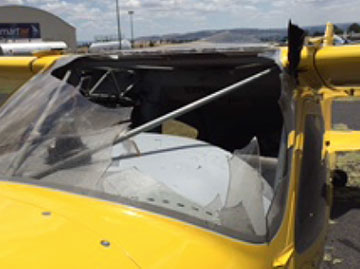An incident where the pilot of a Glasair Sportsman GS-2 was temporarily blinded after a large eagle broke through the windscreen, highlights the serious hazards of aviation wildlife strikes.

On 24 December 2015, the pilot of a Glasair Sportsman GS-2 was conducting a private flight from Southport, Queensland, to Moruya, New South Wales (NSW), with a refuel stop at Mudgee, also in NSW. The pilot was the only person on board.
While cruising at 5,500 ft above mean sea level near Bathurst, NSW, the aircraft collided with a large bird, believed to be a wedge-tailed eagle. The bird broke though the windscreen on the left side of the aircraft and struck the pilot. The collision left the pilot with serious facial injuries and they were temporarily unable to see. The pilot was wearing a headset and spectacles, which were both dislodged and damaged during the collision. Following the birdstrike, the aircraft entered a rapid descent, but the pilot recovered sufficiently to regain control. Despite the broken windscreen and their injuries, the pilot was able to divert to Bathurst Airport and land successfully.
During their ordeal, the pilot had been able to locate the microphone of the headset and transmit a MAYDAY call. But damage to the headset meant they were unable to hear any incoming transmissions. Although air traffic control (ATC) received the MAYDAY call, they did not know the callsign or specific location of the aircraft involved, or the intentions of the pilot. About 30 minutes after the MAYDAY call, the Safety Officer at Bathurst airport contacted ATC to advise them that an aircraft with a broken windscreen (the result of a birdstrike) had landed at Bathurst.
ATSB research report (AR-2104-075) titled Australian aviation wildlife strike statistics provides some insights into the nature and characteristics of birdstrikes. The August 2010 edition of the Flight Safety Foundation magazine (AeroSafety World) includes an article titled Bird Strike Mitigation Beyond the Airport, which provides some interesting comments regarding bird behaviour and the possible effects of a birdstrike on general aviation aircraft.
This incident highlights the serious hazard to aviation presented by birds, not only near aerodromes. A birdstrike can cause substantial damage which has the potential to significantly adversely affect the performance and handling qualities of an aircraft. When declaring an emergency, pilots are encouraged to relay as much relevant information as reasonably possible (acknowledging that the circumstances surrounding this incident made effective communication very difficult). Positional information and information with respect to the intentions of the pilot may be critical to an effective response by emergency services.
Read the report: Birdstrike involving a Glasair Sportsman GS-2, N666GM, near Bathurst, New South Wales, on 24 December 2015


